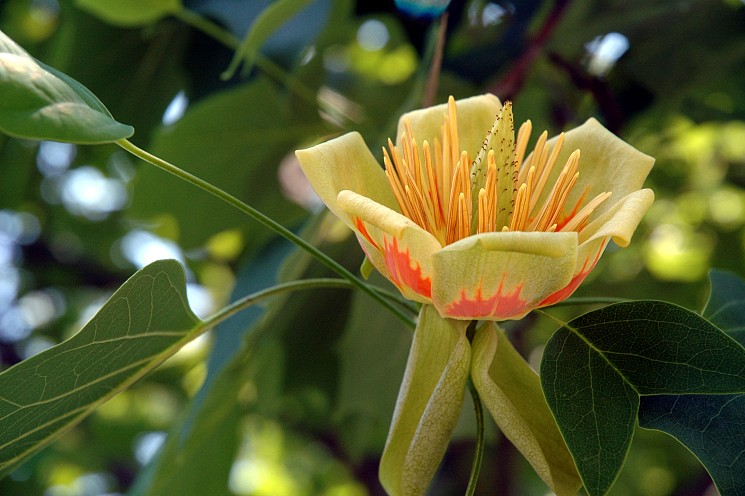Liriodendron tulipifera

“If all musical sounds were to be forever silenced – orchestras, bands, human voices, birds & insects – and I were allowed to retain one sound to cheer me, I would ask that the wind might play in the tree-tops….”
-Charles Burchfield
The tuliptree, Liriodendron tulipifera, is one of those kinds of trees with leaves that seem to flutter joyously in the slightest breeze. In addition to their aural attraction, these leaves have the distinction of not really resembling any other leaf in appearance. The 3 to 8″ long leaves, to some extent, recall the shape of an outline of a tulip. Frequently, almost square on top, the two halves of the leaves, connected by the midvein, look like mirror images with 2-3 small lobes per side. This leaf shape once identified is near impossible to forget. Their autumn color is a clear, bright, golden-yellow.
This deciduous tree, native to our eastern forests, is a member of the Magnoliaceae, the magnolia family. It often reaches heights of 60 to 90 feet, and this “king of the magnolias” has had individuals recorded at top heights of 190′, becoming the tallest species of hardwood in eastern North America. Walt Whitman (1819-1892) called the tuliptree, “the Apollo of trees.” Mount Auburn’s visionary founder, and notable botanist, Jacob Bigelow (1787-1879) described it as, “One of the noblest trees, both in size and beauty, of the American forest.”
Liriodendron tulipifera, the tuliptree, one of only two species found worldwide within the genus, has also been known colloquially by a variety of other common names; yellow poplar, tulip poplar, (although it is not a poplar), popple, whitewood and canoewood. This latter name was cited by Peter Kalm (1716-1779), the great, Swedish-Finnish, explorer/botanist in his Peter Kalm’s Travels into North America, a standard text regarding life in colonial North America, “…call it ‘canoe tree’ for both the Indians and the Europeans often make their canoes from its trunk.” Another reference to this name is of Daniel Boone (1734-1820) transporting his family and belongings within a large, long, single, log of canoewood, down the Ohio River, when moving from Kentucky for Missouri.
Now, let us mention the flowers, which give this tree its tuliptree name. Deferring again to Peter Kalm’s Travels… “The flowers have a resemblance to tulips, look pretty, and though they have no smell to delight the nose, yet the eye is pleased to see trees as tall as full grown oaks covered with tulip-like flowers.” The two-to-three-inch, deep, chalice-shaped, flowers are formed by six, chartreuse-colored petals, each displaying an irregular crescent of bright, orange near the base. This polychromatic floral effect is enhanced, upon closer view, by the multitude of stiff, yellow stamens within this magnolia-shaped flower.
The beauty of these June-occurring flowers often goes unnoticed, as they grow high overhead amongst the large leaves. Look for whole flowers dropped to the ground, by squirrels biting off the tips of branch stems to drink sap flowing in the tree’s vascular system. Many insects, including native bees, gather nectar and pollen from these flowers. The leaves are eaten by caterpillars of the eastern tiger swallowtail butterfly. The seeds eventually produced from the flowers are eaten by red-winged blackbirds, cardinals, evening grosbeaks, American goldfinches, as well as by squirrels, rabbits, mice and other Cemetery fauna.
There are more than twenty tuliptrees many which are now in flower throughout Mount Auburn’s landscape for you to seek out to admire. On your next visit you may look for some of our larger specimens on Elm Avenue, Walnut Avenue, Lime Avenue, Almy Road, Halesia Path, Sweetbrier Path, Bluebell Path, Heath Path, Oak Knoll Path, Robin Path, and Gentian Path among other locations.
*This Horticulture Highlight was originally published in the June 2011 issue of the Friends of Mount Auburn electronic newsletter.
Leave a Reply